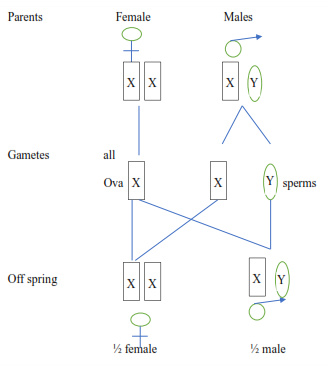
Sex determination in animals
 The medium size chromosome in drosophila melanogaster determines the individual’s sex for which reason they are called the sex chromosome. In the female, the two sex-chromosome, both rod-shaped in appearance, are identical and are known as X-chromosomes. In the male, however, the two sex-chromosome differ from each other one is a rod-shaped X-chromosome, the other is a hook-shaped, and is called Y-chromosome.
The sex chromosomes are the exception to the rule that homologous chromosomes are identical in appearance. Being different they are described as heterosomes; All the other chromosomes, which are identical in appearance, are called autosomes.
Despite this difference, the sex chromosomes are transmitted in a normal mendelian manner as shown below.
The medium size chromosome in drosophila melanogaster determines the individual’s sex for which reason they are called the sex chromosome. In the female, the two sex-chromosome, both rod-shaped in appearance, are identical and are known as X-chromosomes. In the male, however, the two sex-chromosome differ from each other one is a rod-shaped X-chromosome, the other is a hook-shaped, and is called Y-chromosome.
The sex chromosomes are the exception to the rule that homologous chromosomes are identical in appearance. Being different they are described as heterosomes; All the other chromosomes, which are identical in appearance, are called autosomes.
Despite this difference, the sex chromosomes are transmitted in a normal mendelian manner as shown below.

CATEGORIES General
TAGS Dr. Bbosa Science

Thank you ever so for you article post. Keep writing.